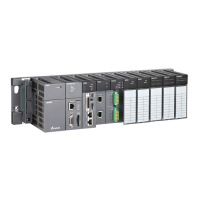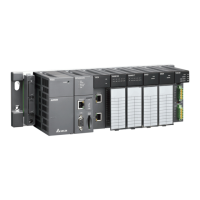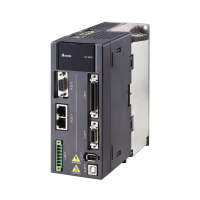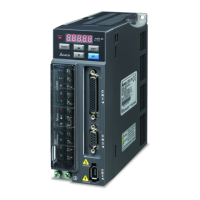AH500 Hardware and Operation Manual
12-14
12.2.3
BUS FAULT LED Indicator’s Being ON
When a CPU module detects an error, the BUS FAULT LED indicator on the CPU module is ON. The BUS
FAULT LED indicator on the CPU module corresponds to the ERROR LED indicator on an I/O module. If an
error occurs in an I/O module, the status of the BUS FAULT LED indicator on the CPU module is the same as
that of the ERROR LED indicator on the I/O module. If there are errors occurring in the I/O modules, the BUS
FAULT LED indicator on the CPU module will be ON. For example, the BUS FAULT LED indicator on the CPU
module will be ON if the ERROR LED indicator on I/O module A is ON and the ERROR LED indicator on I/O
module B blinks. If the ERROR LED indicator on I/O module B still blinks after the error occurring in I/O module
A is eliminated, the BUS FAULT LED indicator on the CPU module will blink. Please refer to sections 12.4 in
this manual for more information about the LED indicators.
Users can get the remedies for the errors detected by a CPU module from the table below. If the error code
which users get is not listed in the table below, users need to check whether the I/O module operates normally.
Please refer to section 12.3 in this manual for more information about the troubleshooting for I/O modules.
Error
Description Remedy
16#0013
The I/O module can not run/stop.
(SM10)
Check whether the setting of the parameter for the
module is correct. If the setting is correct, please check
whether the module breaks down. If the error still occurs,
please contact the local authorized distributors.
16#0014
The procedure of restoring the
system can not be executed.
(SM9)
The contents of the system backup file are incorrect, or
the file does not exist in the path specified. If the file
exists and the procedure of restoring the system can not
be executed, please backing up the system again. If the
error still occurs, please contact the local authorized
distributors. (Please refer to section 7.5 in AH500
Operation Manual, and section 18.2 in ISPSoft User
Manual for more information about the memory card.)
16#1400
An error occurs when the data
is accessed through the
auxiliary processor. (SM9)
Check and eliminate the problem. If the problem persists,
contact the local authorized
16#1401
An error occurs when the data in
the I/O module is accessed.
Check and eliminate the problem. If the problem persists,
contact the local authorized
16#1402
The actual arrangement of the I/O
modules is not consistent with the
Check whether the module table in HWCONFIG is
consistent with the actual arrangement of the I/O
16#1403
An error occurs when the data is
read from the module. (SM9)
Check whether the module operates normally. If the error
still occurs, please contact the local authorized
16#1405
The setting parameter of the
module is not found. (SM9)
Set the parameter in HWCONFIG again, and download it.
16#1407
A communication error occurs
when the data is accessed
through the auxiliary processor.
Check and eliminate the problem. If the problem persists,
contact the local authorized distributors.
16#1409
The extension backplane is
disconnected. (SM9)
1. Check whether the extension backplane is connected
properly and make sure the settings on the HWCOFIG
is the same as the actual placement.
2. Check whether the extension backplane operates
normally, and make sure that the extension backplane
is not affected by noise.

